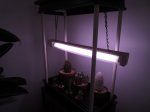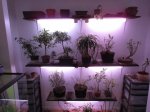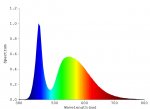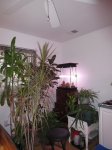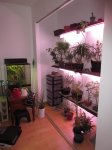Bonsai Nut
Nuttier than your average Nut
I am going to start this thread with this post, add to it as I have time, and eventually compile it into an article.
There have been a lot of requests for information on artificial lighting for bonsai (particularly at this time of year). I wanted to write a reference piece that was both scientifically correct, but accessible to people who don't want to learn phytobiology
Let's start with a few basic terms. Many people think of lighting in terms of "watts" or "wattage". This is an incorrect artifact from the days when all lighting was incandescent, was more or less the same efficiency, and the more power a bulb would draw, the more light it would generate. Wattage is actually an electrical term that indicates the power draw of a light. Volts x amps = watts. You can have a bright light that burns few watts. You can have a dim light that has a high wattage. What we are interested in is LIGHT which is measured in LUMENS.
Even lumens are a little complicated, because lumens are a measurement of all light generated by a source that is visible to the human eye. But to keep things simple, think of lumens as general "brightness" of a light source. If you have a light source that generates a lot of lumens for few watts, that light is considered more "efficient" in terms of generating more light for less cost (in terms of cost of electricity used). For a historical perspective, incandescent bulbs generate about 10-15 lumens per watt. Compact fluorescent bulbs (CFL's) generate 50-60 lumens per watt. LED's generate 100 lumens per watt (or more). (These are broad generalizations using a 60 watt incandescent bulb as a reference point). Even within one type of technology there will be a range of results - with cheaper LED's yielding lower lumens per watt, and more technically advanced LED's yielding higher lumens per watt.
But wait - there's more! Lumens measure light visible to the human eye. Do plants care? Not really. The human eye has evolved to be very sensitive to daylight yellow light. Plants only care about photosynthesis. It turns out that plants have two different types of chlorophyll (creatively named "chlorophyll A" and "chlorophyll B") that absorb light and use it to generate energy for the plant through the process of photosynthesis. Each type of chlorophyll absorbs a slightly different band of light. So as plant keepers we want our light sources to specifically generate light in the bands that plants use for photosynthesis. This type of light has a fancy measurement as well - it is called PAR which stands for "Photosynthetically Available Radiation". For our artificial lighting needs we want lights that generate the most PAR for the lowest cost - anything else is extraneous. This is why professional grow lights generate light that looks strange to our human eyes - they generate light in the narrow bands of red and blue/violet radiation that plants absorb for photosynthesis. Put differently, plants in sunlight appear green to us, because that is the light that they don't absorb
Ok so next let's talk about light spectra...
There have been a lot of requests for information on artificial lighting for bonsai (particularly at this time of year). I wanted to write a reference piece that was both scientifically correct, but accessible to people who don't want to learn phytobiology
Let's start with a few basic terms. Many people think of lighting in terms of "watts" or "wattage". This is an incorrect artifact from the days when all lighting was incandescent, was more or less the same efficiency, and the more power a bulb would draw, the more light it would generate. Wattage is actually an electrical term that indicates the power draw of a light. Volts x amps = watts. You can have a bright light that burns few watts. You can have a dim light that has a high wattage. What we are interested in is LIGHT which is measured in LUMENS.
Even lumens are a little complicated, because lumens are a measurement of all light generated by a source that is visible to the human eye. But to keep things simple, think of lumens as general "brightness" of a light source. If you have a light source that generates a lot of lumens for few watts, that light is considered more "efficient" in terms of generating more light for less cost (in terms of cost of electricity used). For a historical perspective, incandescent bulbs generate about 10-15 lumens per watt. Compact fluorescent bulbs (CFL's) generate 50-60 lumens per watt. LED's generate 100 lumens per watt (or more). (These are broad generalizations using a 60 watt incandescent bulb as a reference point). Even within one type of technology there will be a range of results - with cheaper LED's yielding lower lumens per watt, and more technically advanced LED's yielding higher lumens per watt.
But wait - there's more! Lumens measure light visible to the human eye. Do plants care? Not really. The human eye has evolved to be very sensitive to daylight yellow light. Plants only care about photosynthesis. It turns out that plants have two different types of chlorophyll (creatively named "chlorophyll A" and "chlorophyll B") that absorb light and use it to generate energy for the plant through the process of photosynthesis. Each type of chlorophyll absorbs a slightly different band of light. So as plant keepers we want our light sources to specifically generate light in the bands that plants use for photosynthesis. This type of light has a fancy measurement as well - it is called PAR which stands for "Photosynthetically Available Radiation". For our artificial lighting needs we want lights that generate the most PAR for the lowest cost - anything else is extraneous. This is why professional grow lights generate light that looks strange to our human eyes - they generate light in the narrow bands of red and blue/violet radiation that plants absorb for photosynthesis. Put differently, plants in sunlight appear green to us, because that is the light that they don't absorb
Ok so next let's talk about light spectra...
Last edited:

